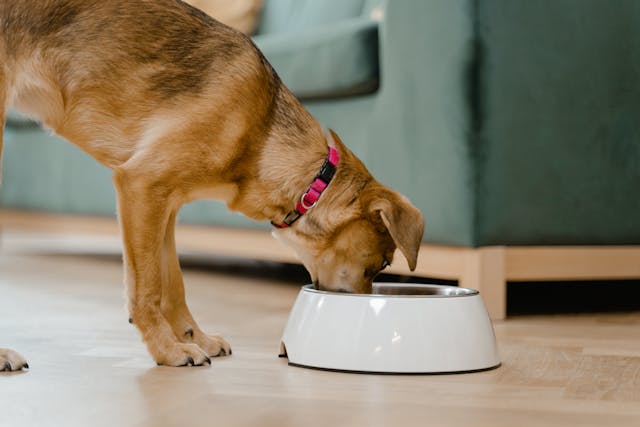Did you know that while about 95% of foreign objects swallowed by dogs pass through their systems without a hitch, the remaining 5% can be life-threatening? As a dog parent, you might not have thought about how to make your pup vomit, but this is a vital lifesaving skill you should have.
Imagine coming home to find your dog has devoured your entire box of chocolates. Panic sets in—what do you do? Dogs are curious creatures with a knack for getting into trouble, often munching on things they shouldn’t. Understanding how to handle these situations can mean the difference between a minor scare and a serious emergency.
In this post, we’ll walk you through everything you need to know about inducing vomiting in dogs: when it’s necessary, safe ways to do it, and important precautions to remember.
Why Do You Need to Make Your Dog Throw Up?
Inducing vomiting in your dog can be important when they’ve eaten or swallowed something harmful. It can save their lives. Here’s why it’s so important in certain situations:
Immediate Removal of Toxins
When your dog eats something dangerous—like toxic food, chemicals, or foreign objects—inducing vomiting can quickly remove the harmful substance from their stomach before it causes serious damage. The faster you act, the more likely you are to prevent the toxin from being absorbed into their bloodstream.
Preventing Long-Term Health Complications
Some substances, such as certain medications, foods (like chocolate or grapes), or household items, can cause long-term damage to your dog’s organs if left in their system. By inducing vomiting, you help reduce the likelihood of severe consequences, like liver or kidney failure.

Reducing the Need for Invasive Treatments
In some cases, inducing vomiting can prevent the need for more invasive treatments, like surgery or endoscopy, to remove objects or toxins from your dog’s stomach. By removing the harmful substance early, you might avoid complex and costly medical procedures.
Acting as a First Response
Vomiting may be the first line of defense in some poisoning cases. When immediate vet care isn’t available, inducing vomiting (under professional guidance) can buy you time until you can get your dog to the vet.
Limiting Absorption of Poisons
Certain poisons and chemicals start causing harm as soon as they’re absorbed into the system. Inducing vomiting helps limit how much of the toxin gets absorbed, reducing the severity of symptoms and improving your dog’s chances of a full recovery.
Common Symptoms of Toxic Ingestion in Dogs
If you suspect your dog has ingested something they shouldn’t have, look out for the following symptoms:
- Vomiting
- Drooling excessively
- Seizures
- Lethargy or weakness
- Difficulty breathing
- Diarrhea
- Unusual behavior or restlessness
Your dog’s health and safety are at risk if you don’t act quickly in an emergency.
What to Do if Your Dog Eats Something Dangerous
If your dog ingests something harmful, here’s what you need to do:
Stay Calm
Keep cool and assess the situation—know what, how much, and when your dog ate the item.
Call a Vet or Poison Control
Contact your vet or a pet poison helpline immediately. Provide details like your dog’s size, what they ate, and any symptoms. They’ll guide you on the next steps.
Monitor Symptoms
Watch your dog for signs of distress, such as drooling, lethargy, or unusual behavior. If symptoms worsen, get to the vet quickly.
How to Safely Use Hydrogen Peroxide to Induce Vomiting in Dogs
Inducing vomiting in your dog can be a life-saving step, but it’s important to only do so under the guidance of a vet. Using hydrogen peroxide incorrectly can do more harm than good, so always consult a vet or a poison control center before proceeding.
If your vet has recommended inducing vomiting at home, here’s how you can safely use hydrogen peroxide:
Measure the Right Dose
Use a 3% hydrogen peroxide solution—this is the safe concentration. The recommended dosage is 1 teaspoon (about 5 ml) per 10 pounds of body weight. You can repeat this dose every 10 minutes, but only up to three times, until your dog vomits.
Administer the Hydrogen Peroxide
Carefully squirt the hydrogen peroxide into your dog’s mouth using a syringe or turkey baster. Make sure they swallow it and try to stay calm to help your dog feel more at ease.
Wait for Your Dog to Vomit
Most dogs will vomit within 15-20 minutes of receiving hydrogen peroxide. If your dog does not vomit after the first dose, you can repeat it but do not exceed three doses in total.
Monitor Your Dog Closely
After your dog vomits, keep a close eye on them for any signs of distress or complications. Let your vet know how things are progressing so they can guide you on any further steps.
What Not to Do if Your Dog Ingests Something Dangerous
If you suspect your dog has ingested something harmful, knowing when not to induce vomiting is crucial. Do not induce vomiting in these situations:
If Your Dog Is Unconscious or Lethargic
If your dog has lost consciousness or seems extremely lethargic, do not attempt to induce vomiting. Signs like a slow heartbeat, inability to stand, or excessive sleepiness indicate a serious condition that requires immediate veterinary attention. Inducing vomiting in such cases could worsen their situation.
If They’ve Ingested Caustic Substances
If your dog has swallowed something caustic—like bleach or drain cleaner—do not induce vomiting. These substances can cause severe burns on the way down and potentially even more damage coming back up. Instead, contact your vet right away for guidance.
Watch Out for Petroleum Distillates
If your dog has consumed petroleum distillates such as kerosene, mineral spirits, or gasoline, inducing vomiting can be dangerous. They can inhale these oily substances if you make them throw up, leading to respiratory issues. Your vet can provide the best advice on how to handle the situation.
If Your Dog Is Already Vomiting
According to the American Society for the Prevention of Cruelty to Animals (ASPCA), don’t induce vomiting if your dog is already doing it.
This may seem counterintuitive, but your pup’s body is already attempting to expel the harmful substance. Instead, focus on keeping your dog calm and seek vet care.

Timing Matters
If it’s been more than two hours since your dog ingested the harmful item, avoid inducing vomiting. After this time frame, the substance typically moves from the stomach to the intestines, where vomiting won’t help. Contact your vet for advice on the next steps.
Be Cautious with Sharp Objects
If your dog has swallowed something sharp or pointy, inducing vomiting is a no-go. Sharp objects can cause internal damage if brought back up, so it’s best to consult your vet immediately.
Always remember that, sometimes, your dog might not show severe symptoms like lethargy or vomiting after ingesting a potential toxin. In such cases, and with your vet’s approval, you might just need to monitor your dog at home.
Keep an eye out for any changes in behavior, appetite, or energy levels. If anything seems off, don’t hesitate to reach out to your vet.
Truffle Paws Is Perfect for Dog Emergencies
At Truffle Paws, we understand that your dog’s health is your priority, especially during emergencies like when they’ve eaten something dangerous. Our comprehensive insurance plans cover emergency vet visits, ensuring you’re prepared when the unexpected happens.
Don’t leave your dog’s well-being to chance. With Truffle Paws, you can focus on getting the right care without financial worry. Visit our website or reach out to our customer service today to find out how we can support your dog in their time of need.






